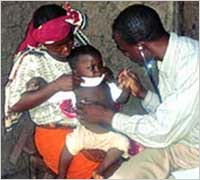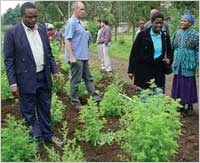ECONOMICS AND TRADE | Achieving growth through open markets
23 April 2008
Malaria: Partnering to Find a Cure
Innovative international group supports research against deadly disease

(The following article is taken from the U.S. Department of State publication, Focus on Intellectual Property Rights.)
Malaria: Partnering to Find a Cure
By Richard Wilder and P. V. Venugopal
Every year, 300 to 500 million people around the world are infected with malaria, and more than one million people die of the disease. In Africa, the burden of malaria is on the rise for the first time in 20 years, fueled by the rapid spread of resistance to widely used malaria drugs like chloroquine. As a result, malaria is the leading cause of death for children in Africa, killing 3,000 every day. These statistics represent an international disaster and a public health failure.
Despite the massive burden malaria represents for developing countries, only four of almost 1,400 new medicines developed worldwide between 1975 and 1999 were antimalarials. This is not enough to tackle the problem, since new drugs are needed to offset the malaria parasite's pattern of developing resistance to the ones in use.
In 1999, talks between the World Health Organization (WHO) and the International Federation of Pharmaceutical Manufacturers Associations (IFPMA), in collaboration with a number of institutions, such as the World Bank and the Rockefeller Foundation, led to the creation of the Medicines for Malaria Venture (MMV). MMV is a nonprofit organization that brings public, private, and philanthropic sector partners together to fund and manage the discovery, development, and registration of new medicines for the treatment and prevention of malaria.

After just five years of operation, MMV is managing the largest-ever portfolio of malaria drug research, with 21 projects in various stages of development. Such a rapid advance was made possible by MMV's pioneering collaboration with nearly 40 public and private institutions around the world. MMV, for example, looked to pharmaceutical companies doing anticancer therapy research that has led to the development of compounds that are highly active against the malaria parasite. These companies share their knowledge with MMV project teams once they enter into agreements with MMV.
An integral part of agreements negotiated by MMV is its innovative management of the intellectual property that its partners bring to the table. MMV manages the ownership and licensing of intellectual property so that the partner's interests – whether academic, commercial, or purely in the public interest – are reflected in the terms of agreements. Depending on the circumstances, MMV may own the intellectual property outright, retain licenses to the intellectual property, or have conditions in its agreements that, if not met, cause the intellectual property rights (IPR) to be transferred back to MMV.
In many cases ownership of the intellectual property rights is not necessary, since MMV is working with a company to both discover and develop a promising compound as an antimalarial. In those cases, for example, the company may retain ownership of the intellectual property rights and use them while performing their obligations to MMV to develop and bring an antimalarial to market. The agreement will specify certain conditions that have to be met, including price specifications and other conditions relating to access to the antimalarial by people in poorer countries. It is only in cases where the partner company cannot – or will not – fulfill its obligations that MMV needs the rights to be returned to it, so as to go forward with the project with a different partner.
Regardless of the nature of the intellectual property rights held by MMV, the determining factor is its ability to carry out its mission. Consequently, the focus is not on the intellectual property rights per se, but on the path that MMV must take to ensure that the new antimalarials being developed under its supervision are brought to market and made affordable and accessible to those who need them in the developing world. The intellectual property rights, then, are a tool to bring the partners in a given project together for a common goal and to ensure that the path that MMV must take to achieve its goals is clear.
One of MMV's most promising drug candidates is a synthetic peroxide, first discovered by scientists from the University of Nebraska Medical Center, Monash University in Australia, the Swiss Tropical Institute, and Roche Pharmaceuticals. The drug resembles plant-derived artemisinins, today's most effective antimalarials. Through an agreement arranged by MMV, Roche Pharmaceuticals has transferred more than three years of research results on synthetic peroxides to the Indian pharmaceutical firm Ranbaxy, to speed the drug's development at the lowest possible cost.
Today, the drug is moving into clinical development, and could become the most important new weapon against malaria in a generation. This illustrates the result of innovative management of intellectual property rights by MMV to accomplish its goal – and that of its partners – of bringing modern medicines to market to treat malaria.
[Richard Wilder is a partner in the Washington, D.C., office of Sidley Austin Brown & Wood. Dr. P.V. Venugopal is director of international operations for the Medicines for Malaria Venture.]